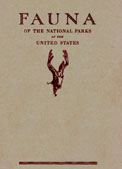![]()

Fauna Series No. 1
![]() Methods
Methods
Fauna of the National Parks
of the United States
RECAPITULATION
The foregoing discussion explains the wherefore of the several steps in procedure developed in the course of the preliminary wild life survey and which were followed out as far as possible considering the broad field and the time allowed. This plan is here presented in outline form, indicating the methods for securing the data required in the first steps and suggesting how the last step, the administrative plan, can be predicated on this data.
OUTLINE OF FAUNAL-SURVEY'S PROCEDURE
I. Determine original status of fauna in the park region.
Object –
A. To define the goal of wild-life management.
B. To establish definitely the comparative basis for analyzing subsequent faunal changes.
Method –
A. Study the evidence on the ground.
- Old game trails, salt licks, wallows, etc.
- Skeletal remains, horns, antlers, etc.
B. Interview pioneers, early residents, etc.
C. Search written records.
- Letters and diaries.
- Printed sources, inclusive of periodicals, books, scientific reports, etc.
- Paintings and drawings by Indians and white men.
II. Determine the history of the fauna of the region under white man's influence.
Object –
A. To trace causes of present conditions.
B. To learn what unfavorable influences may be averted in history yet to be made in newer projects.
Method (in general, the same methods as outlined under I, above, are applicable) –
A. Study the era prior to creation of park by the several steps of economic development in that region.
- Direct influences.
a. Trapping.
b. Hunting for sport.
c. Market hunting.- Indirect influences.
a. Grazing.
b. Agriculture.
c. Lumbering.
d. Railroad development.B. Study history of the fauna under park administration.
- Investigate history of wild-life administration.
a. Poaching and patrol.
b. Predatory-animal control.
c. Other protection and management measures.- Determine effects of development as a national park.
a. Increase of visitors.
b. Road and structures developments.
c. Developments adjacent to park boundaries.
III. Intensive survey of present vertebrate life of the park.
Object – To learn as much as possible about all forms and their economy.
Method –
A. Make a complete study skin collection for the park museum.
B. Work out life histories of all species.
- Concentrate first on species facing greatest danger and carry on to eventually include all.
- Study the park animal in relation to the status of that species throughout its range.
- Study other attempts to conserve certain species for hints in park work.
C. Study the human factor as a permanent factor in the ecology of the area.
IV. Develop a management plan.
Object –
A. To maintain elements in present picture that still approximate the primitive state.
B. To devise ways of restoring species which have departed from their original status.
C. To make adjustments for species which can only be saved under semiartificial conditions.
Method – The management plan will be based on the data secured in the first three steps of the survey and will be developed as the result of experience in applying the knowledge so gained.
Top
Last Modified: Tues, Feb 1 2000 07:08:48 pm PDT
http://www.cr.nps.gov/history/online_books/fauna1/fauna2e.htm
![]()